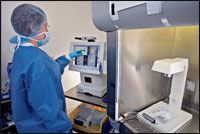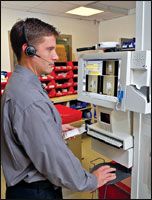Publication
Article
Pharmacy Times
feature: Telepharmacy Improves Safety in Chemotherapy Preparation
Author(s):
The University of Kansas Hospital's use of ScriptPro's Telepharmacy brings added safety to the preparation process for chemotherapy medications.

The University of Kansas Hospital'sdecision to implement telepharmacyin the chemotherapy preparationroom in July 2007 has demonstratedsafety improvements.
Because there is no specific technologyavailable for chemotherapy preparation,the Kansas City?based hospitalturned to ScriptPro Inc. In March 2007,the hospital met with the company aboutusing their telepharmacy product in thechemotherapy preparation area, andScriptPro modified the system to meetthe particular needs in the pharmacydepartment.
"Given it didn't exist in a form to meetour needs, it was a quick turnaroundfrom March to July," said Brian O'Neal,MS, PharmD, assistant pharmacy directorat the hospital. "The system is easy touse and the staff was trained in a week."
Preparation of chemotherapy medicationsis one of the highest risk practicesin hospital pharmacies. Selecting theright drug, drawing up the appropriatevolume, and injecting it into the intravenous(IV) bag for the correct patientare critical. A pharmacist is required tooversee the process. Yet, with limitedpharmacist resources and the complicationsof clean room operations, step-by-stepoversight is generally impossible.
Pharmacist oversight at the Universityof Kansas and other hospitals involvesverifying the chemotherapy preparationsusing the syringe pull-back method. Inthe isolated chemotherapy preparationroom, a technician fills the syringe withmedication and injects it into the IV bag.After the fact, the technician pulls backthe empty syringe to show the pharmacisthow much medication was injected.

The implementation of ScriptPro'sTelepharmacy improved the process forthe 508-bed hospital, which has 125 to150 chemotherapy drugs go through thepharmacy system a week. Working withScriptPro, the pharmacy administratorsplaced a telepharmacy inspection camerato take digital images at variousstages of the chemotherapy preparationprocess in a biological safety cabinet inthe clean room. First, the technicianscans the bar code on the vial. Then, thetechnician takes photos of the worklabel, the vial, the fluids being used, andfinally, the syringe, before injection intothe bag. A pharmacist views the imagesfrom a check station when verifying thefinished product.
"It [the system] allowedus to get the safety benefitwe wanted while still allowingthe pharmacist tosee everything," he said.Plus, it allows "us to keepour clinical pharmacists onthe floor as part of a multidisciplinaryarea."
Dr. O'Neal and his colleaguesauthored "Innovationsin ChemotherapyPreparation Safety: Use ofTelepharmacy and BarcodeTechnology in the IV Admixture Area,"which won a 2007 American Society ofHealth-System Pharmacists Best PracticeAward in Health-System Pharmacy.
The paper documented the telepharmacyprocess and the outcomes after 1month of using the system. The processdemonstrated safety improvements in 4main areas:
- Verifying chemotherapy productswith bar code technology helpedensure that the correct drug wasselected
- Inspecting photographs of the syringebefore it was injected into thebag of fluid increased the likelihoodof detecting technicians' errors
- Digitally enlarging the small font ofthe chemotherapy vials helped pharmacistsaccurately check the finishedproduct
- Disposing of contaminated syringesand vials in the chemotherapy preparationarea reduced the risk of contaminatingother areas of the clean room
During the data collection period fromJuly 1, 2007 to July 31, 2007, the use oftelepharmacy and bar code technologyresulted in a pharmacist's intervention in4 of 363 prepared doses.







